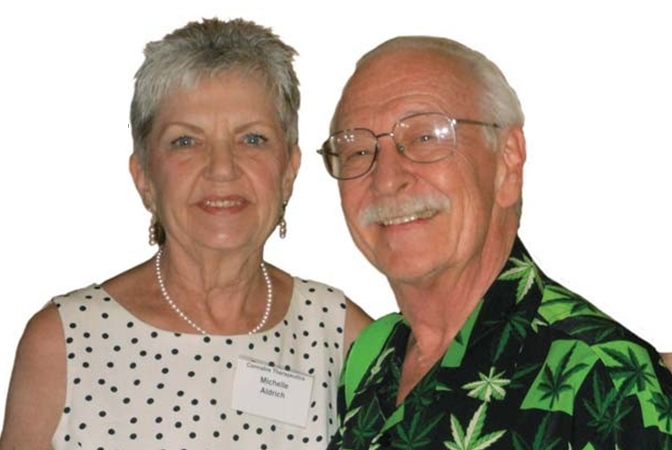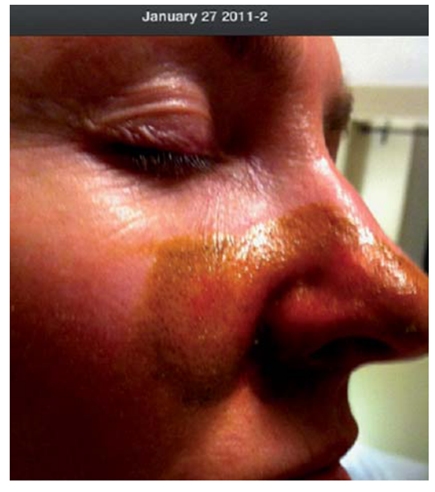
Milagro Oil for Lung Cancer
By Mary Lou Smart
www.medicalcannabisart.com
Compassionate care advocates Michelle and Michael Aldrich at Patients Out of Time’s Seventh National Clinical Conference on Cannabis Therapeutics.
MICHELLE ALDRICH: MILAGRO OIL FOR LUNG CANCER
For the fight of her life, an advocate’s arsenal includes whole plant therapy.
For Michelle Aldrich, Patients Out of Time’s Seventh National Clinical Conference on Cannabis Therapeutics in Tucson, Arizona in April was a homecoming. She found her life’s calling in advocacy when she founded an Alateen Program in San Antonio, Texas in 1958. She supported drug policy reform, first while living in Washington D.C. and later in California. Living in San Francisco throughout an HIV-AIDS epidem- ic that killed 46 of her friends in one year alone, she pushed for needle exchange programs. She worked on California’s Proposition 215, the 1996 ballot initiative that legalized the medical use of marijuana in the state, and then helped to set up its dispensary protocol in San Francisco. She is an advisory board member of Patients
Out of Time and of the California chapter of NORML.
In January, when diagnosed with lung cancer, Aldrich, 65, began the toughest battle of her life. A tumor was found on her lung, and cancer cells were also found in three lymph nodes. It was estimated that the disease might have been lurking in her body for over a year, putting progno- sis estimates between 2 and 5 percent.
Her dedication to compassionate care and community causes has led to an incredible network of support that includes friendships with Donald Abrams, M.D., chief of Hematology and Oncology at San Francisco General Hospital; Ethan Russo, M.D., senior medical advisor, GW Pharmaceuticals; and integrative medicine guru Andrew Weil, M.D. All have helped her through this difficult time.
Following the advice of her oncologist, Aldrich began a
full regimen of chemotherapy drugs
including Avastin, Carboplatin, Alimta and Neulasta. Avastin has been
shown to slow the growth of new
blood vessels. Alimta inhibits three
enzymes with a goal of preventing
the for- mation of DNA and
RNA, required for
the growth and
survival of both normal and cancer cells. Carboplatin also interacts with DNA. Neulasta reduces the risk of infection in patients receiving chemotherapy, which is known to decrease infection-fighting white blood cells.
The experience drained her. She was nauseous six or seven times each night, and was not sleeping. She lost her appetite. She lost 20 pounds.
Long-time advocates to the cause of making marijuana use legal and safe, Michelle and her husband Michael knew to incorporate cannabis into the therapy. Within one week, she was taking a weak dose of cannabis oil with the goal of working up to a pure concentration. She reports that the taste of the oil extraction is awful.
Upon diagnosis, Dr. Abrams recommended a strict diet — no sugar, no alcohol, no dairy, little meat and lots of fish
— to starve estrogen-craving, sugar-hungry cancer cells. Dr. Weil, who supports a similar anti-inflammatory diet in his integrative medicine program, offered similar advice.
When discussing the new diet, Aldrich laughs and her eyes sparkle.
“I grew up in Texas,” she said. “I’m a meat eater. Meat and potatoes, and so is Michael. We’ve been friends of Andrew’s for 40 years, but that doesn’t mean we follow his diet. I can’t even stand carrots. I hate fish, and I’m eat- ing fish every night.”
While she initially referred to her cannabis oil as Rick Simpson’s oil, her medicine is made by a chemist at WoMen’s Alliance for Medical Marijuana (WAMM), a patients and caregivers collective in Santa Cruz, California. The cannabis grown at the collective is used to make the extraction, which WAMM has named, at the suggestion of a Spanish patient, Milagro Oil. Aldrich’s oil is made with a blend of Indica and Sativa strains.
Valerie
Corral, WAMM director, doesn’t make any specif-
ic claims about the oil. An epileptic, Corral experienced as many as five grand mal seizures a day, with loss of con- sciousness and violent muscle contractions, before she began smoking cannabis. She’s been growing cannabis for her own illness for 38 years. She has been collecting patient data for 18 years, and said that patients report that the oil helps with pain and nausea.
In addition to his work at San Francisco General, Dr. Abrams is also a cancer and integrative medicine special- ist at the University of California, San Francisco, Osher Center for Integrative Medicine, where he provides inte- grative medicine consultations for cancer patients and has completed research in complementary and alternative therapies including mind-body treatments, botanical ther- apies, medical use of marijuana and traditional Chinese medicine herbal therapies.
A speaker at Patients Out of Time’s conference, he spoke about cannabis therapy as a complement to conventional care. His patient research indicates that cannabinoids have anti-inflammatory effects, are effective in preclinical mod- els of neuropathic pain, and can stimulate the appetite. His randomized controlled trials have shown that smoked cannabis is an effective treatment in patients with painful HIV-related peripheral neuropathy.
Dr. Abrams advised against putting too much faith in online videos such as Rick Simpson’s that promote cannabis oil as a cancer cure. He gave as an example a Hodgkin’s patient who lost precious time self-medicating with cannabis oil when a proven chemo regimen could have prevented what occurred, which was cancer racing through his body to the point where he could not regain lost ground. Abrams said that it saddened him to see peo- ple betting on unproven science.
“Cannabis may be a good adjunct, but not a cure,” he said. “I don’t think that we can claim that these things cure cancer. We want to say that we are integrating things that comple- ment conventional therapy.”
The story of Rick Simpson — whereabouts
unknown after well-publicized accounts of run-ins with the Royal Canadian Mounted Police — is easily found online, as is Run From
the Cure, his video that discloses a basic hemp
oil recipe. Cram-packed with testimonials from relatives, neighbors and friends
that he gave the oil to, the video includes disclaimers about
the hazards of making the
oil extract as well
as claims that it will cure all kinds of aches,
pains, infections and diseases, even cancer.
While online videos such as Rick
Simpson’s might
seem far-fetched, research outside of the United States continues to show the
potential of cannabis in
fighting cancer.
At the convention, Christina Sanchez, PhD, a clinician at Complutense University of Madrid, Spain, spoke about phytocannabinoids in the treatment of breast and brain cancer. Ten years ago, and quite by accident, she and fellow colleagues realized that cannabinoids used in experimentation were killing cancer cells. Curious, they did a bit of research and realized that the phenomena of cannabinoids attacking cancer cells had been found before, as reported in the Washington Post in 1974, by scientists at the Medical College of Virginia. Following this indoctrination into the United States’ anti-science Prohibition on a harmless plant, they designed a few basic studies with rats that indicated that cannabinoids do, in fact, interact with CB1 and CB2 receptors, caus- ing cell death. Sure enough, the scientists at the Medical College of Virginia were onto something.
The initial experiments in Madrid have resulted in more than 10 years of solid research. Cannabis seems to have the ability to block tumor growth and block metastasis of cancer cells. Combinations of cannabinoids have shown profound anti-tumor responses. Moving on, they focused on certain types of treatment-resistant tumors in breast cancer, in animals, and again found strong pre- clinical evidence that phytocannabinoids exhibit strong anti-tumor effects with no toxic side effects.
Encouraged by this strong preclinical evidence, physi- cians in Madrid are stepping forward to participate in clinical trials with humans.
In the United States, despite the federal government’s Prohibition on compassionate care, courageous souls like Michelle Aldrich, bolstered by faith in what they’ve learned over the years, pave the way.
From the initial diagnosis, Aldrich’s approach has been to do everything possible to boost her chances of sur- vival. Finding the cannabis oil to be unpalatable, she transferred it into capsules, which she takes twice a day. She noticed a profound change in her body chemistry — extremely dry eyes and mouth — the day after her first dose of pure oil extract. To help with nausea and anxi- ety, she also occasionally uses a vaporizer and a CBD- rich tincture.
Aldrich wants to make sure that her experience is docu- mented. Her first CT scan following four rounds of chemotherapy and ongoing cannabis oil treatment show that the tumor in her lung has shrunk 50 percent in size.“I want to make sure that we have established protocols for chemo and cannabis oil,” she said, adding, “So that other people will know how to do it and what to expect.”







